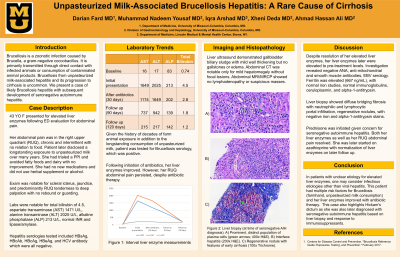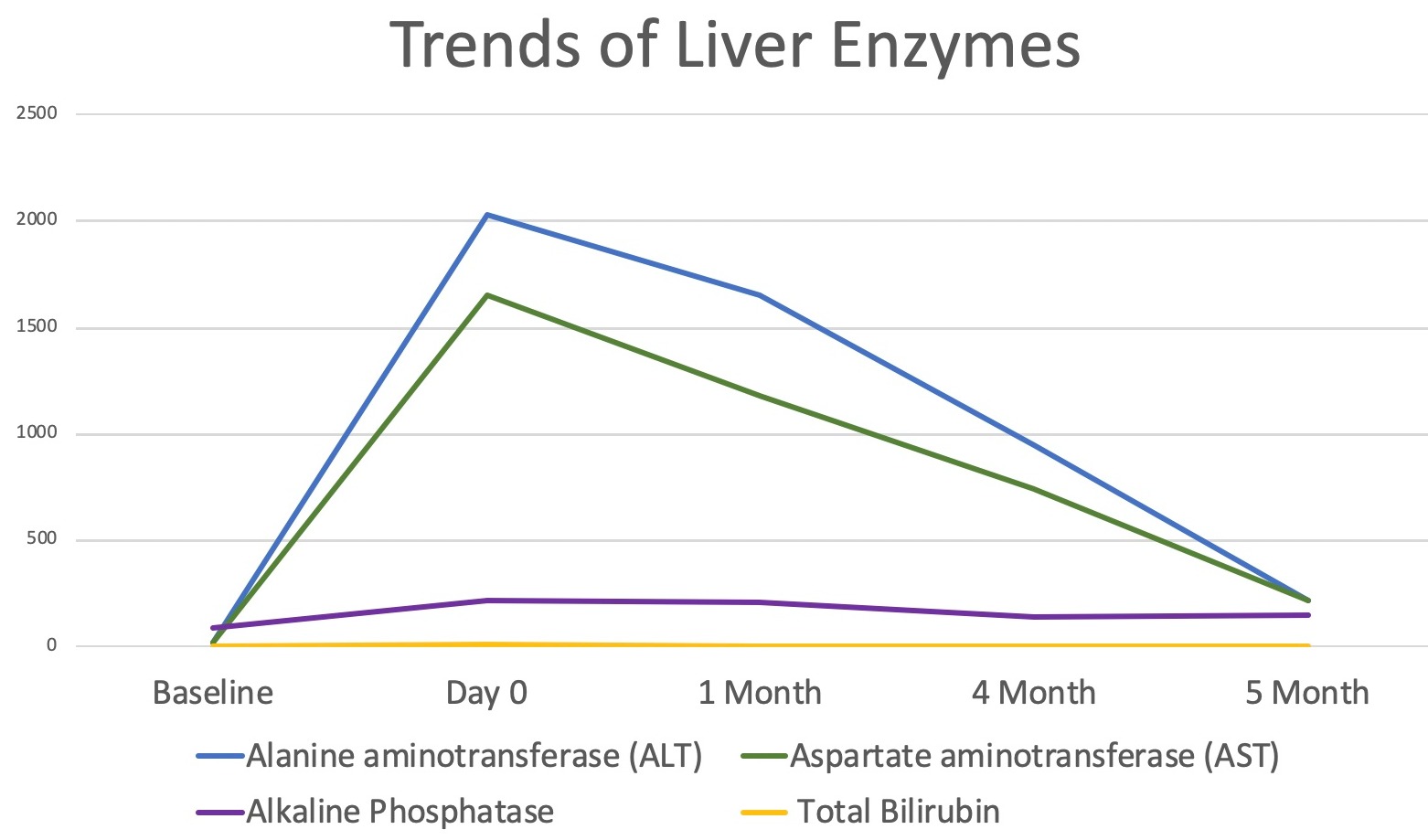Sunday Poster Session
Category: Liver
P1041 - Unpasteurized Milk-Associated Brucellosis Hepatitis: A Rare Cause of Cirrhosis
Sunday, October 22, 2023
3:30 PM - 7:00 PM PT
Location: Exhibit Hall

Has Audio
.jpg)
Darian Fard, MD
University of Missouri
Columbia, MO
Presenting Author(s)
Darian Fard, MD1, Muhammad Nadeem. Yousaf, MD2, Iqra Arshad, MD3, Xheni Deda, MD2, Ahmad Ali, MD4
1University of Missouri, Columbia, MO; 2University of Missouri-Columbia, Columbia, MO; 3Lincoln Medical Center, New York, NY; 4Missouri University Hospital, Columbia, MO
Introduction: Brucellosis is a zoonotic infection caused by the gram-negative coccobacillus Brucella species. It is primarily transmitted through direct contact with infected animals or consumption of contaminated animal products. Brucellosis associated acute hepatitis and its progression to cirrhosis is uncommon.
Case Description/Methods: A 43-year-old female with history of consuming unpasteurized milk from her own livestock presented to ER with right upper quadrant (RUQ) pain and jaundice. She denied using alcohol or herbal supplements. Vitals were notable for tachycardia 113/min. Exam was remarkable for scleral icterus, jaundice and RUQ tenderness. Labs revealed elevated total bilirubin (TB) 4.5 mg/dL, AST 1471 U/L, ALT 2025 U/L, Alkaline phosphatase (ALP) 213 U/L, normal INR, WBC, lipase, and amylase. Abdominal ultrasound showed normal liver morphology, patent vasculature, slightly edematous gallbladder wall without gallstones and nondilated common bile duct. Abdominal CT showed mild hepatomegaly, small gallstones/sludge without focal hepatic lesions. Further workup revealed negative hepatitis serologies, negative ANA, anti-mitochondrial and smooth muscle antibodies, EBV IgM, however positive IgG. Ferritin was elevated (667 ng/mL), with normal iron studies, normal immunoglobulins, ceruloplasmin, and alpha-1-antitrypsin. Liver biopsy demonstrated chronic hepatitis with mild cholestasis, diffuse bridging fibrosis with extensive neutrophilic and lymphocytic infiltration of portal tracts, two regenerative nodules. Negative staining for iron, alpha-1-antitrypsin. A trial of prednisone slightly improved her transaminitis but her symptoms persisted. She later disclosed of her previous diagnosis of brucellosis when she has similar episode of acute elevation of liver enzymes. Her Brucella serology was positive and she was treated with doxycycline 100 mg BID for 6 weeks. She was recommended to avoid direct contact with infected animals or consumption of unpasteurized mild. Her symptoms resolved and liver enzymes trending down (figure1).
Discussion: Brucellosis should be in the differential of acute hepatitis in patients with exposure to livestock and consumption of unpasteurized dairy products. Prompt recognition and treatment of brucellosis hepatitis are crucial to prevent disease progression to cirrhosis and its complications. Clinicians should remain vigilant about this atypical presentation of brucellosis and promote public awareness of the risks associated with the consumption of unpasteurized dairy products.

Disclosures:
Darian Fard, MD1, Muhammad Nadeem. Yousaf, MD2, Iqra Arshad, MD3, Xheni Deda, MD2, Ahmad Ali, MD4. P1041 - Unpasteurized Milk-Associated Brucellosis Hepatitis: A Rare Cause of Cirrhosis, ACG 2023 Annual Scientific Meeting Abstracts. Vancouver, BC, Canada: American College of Gastroenterology.
1University of Missouri, Columbia, MO; 2University of Missouri-Columbia, Columbia, MO; 3Lincoln Medical Center, New York, NY; 4Missouri University Hospital, Columbia, MO
Introduction: Brucellosis is a zoonotic infection caused by the gram-negative coccobacillus Brucella species. It is primarily transmitted through direct contact with infected animals or consumption of contaminated animal products. Brucellosis associated acute hepatitis and its progression to cirrhosis is uncommon.
Case Description/Methods: A 43-year-old female with history of consuming unpasteurized milk from her own livestock presented to ER with right upper quadrant (RUQ) pain and jaundice. She denied using alcohol or herbal supplements. Vitals were notable for tachycardia 113/min. Exam was remarkable for scleral icterus, jaundice and RUQ tenderness. Labs revealed elevated total bilirubin (TB) 4.5 mg/dL, AST 1471 U/L, ALT 2025 U/L, Alkaline phosphatase (ALP) 213 U/L, normal INR, WBC, lipase, and amylase. Abdominal ultrasound showed normal liver morphology, patent vasculature, slightly edematous gallbladder wall without gallstones and nondilated common bile duct. Abdominal CT showed mild hepatomegaly, small gallstones/sludge without focal hepatic lesions. Further workup revealed negative hepatitis serologies, negative ANA, anti-mitochondrial and smooth muscle antibodies, EBV IgM, however positive IgG. Ferritin was elevated (667 ng/mL), with normal iron studies, normal immunoglobulins, ceruloplasmin, and alpha-1-antitrypsin. Liver biopsy demonstrated chronic hepatitis with mild cholestasis, diffuse bridging fibrosis with extensive neutrophilic and lymphocytic infiltration of portal tracts, two regenerative nodules. Negative staining for iron, alpha-1-antitrypsin. A trial of prednisone slightly improved her transaminitis but her symptoms persisted. She later disclosed of her previous diagnosis of brucellosis when she has similar episode of acute elevation of liver enzymes. Her Brucella serology was positive and she was treated with doxycycline 100 mg BID for 6 weeks. She was recommended to avoid direct contact with infected animals or consumption of unpasteurized mild. Her symptoms resolved and liver enzymes trending down (figure1).
Discussion: Brucellosis should be in the differential of acute hepatitis in patients with exposure to livestock and consumption of unpasteurized dairy products. Prompt recognition and treatment of brucellosis hepatitis are crucial to prevent disease progression to cirrhosis and its complications. Clinicians should remain vigilant about this atypical presentation of brucellosis and promote public awareness of the risks associated with the consumption of unpasteurized dairy products.

Figure: Trends of Liver Enzymes
Disclosures:
Darian Fard indicated no relevant financial relationships.
Muhammad Yousaf indicated no relevant financial relationships.
Iqra Arshad indicated no relevant financial relationships.
Xheni Deda indicated no relevant financial relationships.
Ahmad Ali indicated no relevant financial relationships.
Darian Fard, MD1, Muhammad Nadeem. Yousaf, MD2, Iqra Arshad, MD3, Xheni Deda, MD2, Ahmad Ali, MD4. P1041 - Unpasteurized Milk-Associated Brucellosis Hepatitis: A Rare Cause of Cirrhosis, ACG 2023 Annual Scientific Meeting Abstracts. Vancouver, BC, Canada: American College of Gastroenterology.
